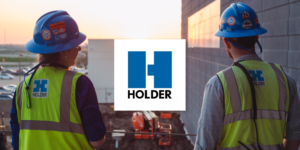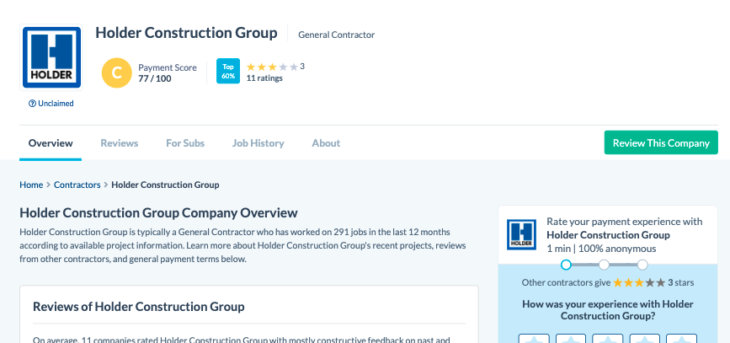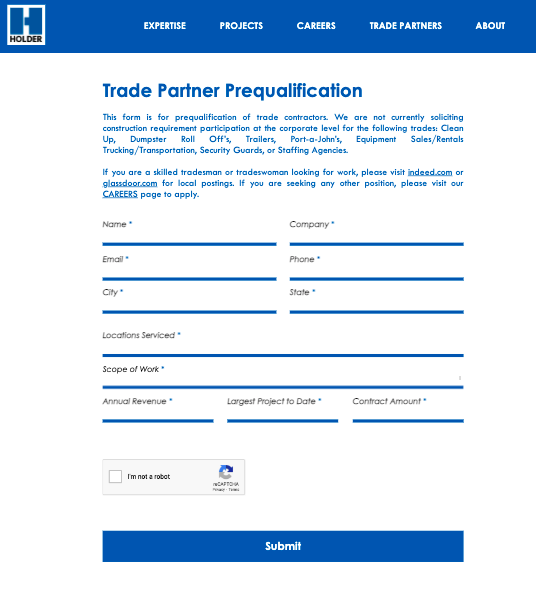
Holder Construction is one of the biggest general contracting companies in the country, and hundreds of subcontractors bid on their projects each year. However, approaching a big GC like Holder for the first time can be overwhelming. There are a lot of requirements you’ll need to meet and steps you’ll need to take. This is the subcontractor’s guide to Holder Construction.
Read on to learn more about the company, including their payment history, payment practices, prequalification practices, and more.
About Holder Construction
Since their humble beginnings in 1960, Holder Construction has grown to be one of the most prominent general contracting companies in the country. Thanks to their hard-working mentality and commitment to client satisfaction, Holder brought in a revenue of $4.4 billion in 2019, and they sit in 20th place on ENR’s Top 400 Contractors list for 2020.
Holder specializes in the following markets:
- Aviation
- Commercial
- Corporate
- Data and technology
- Higher education
- Hospitality
- Interiors
- Special use
For those markets, Holder provides the following services:
- Construction management
- Planning and design support
- Virtual design & construction
- Preconstruction
- Prefabrication
- MEP/building technology
- Safety and risk management
- Sustainability
As a testament to their varied expertise and market reach, Holder Construction has participated in several notable projects:
- Terminal B & C, Denver International Airport – Denver, CO
- Devon Energy World Headquarters – Oklahoma City, OK
- Moss Arts Center, Virginia Tech – Blacksburg, VA
- Mercedes Benz Stadium – Atlanta, GA
- Sky Club Program, Delta Airlines – Various locations
Holder Construction’s operations span seven offices (Atlanta, Charlotte, Dallas, Denver, Phoenix, San Jose, and Washington D.C.) and they have projects in over 30 states.
Before working with Holder Construction
Before you reach out to Holder Construction, you should prequalify them to make sure their practices are a good match to yours. Prequalifying a general contractor gives you the opportunity to look through a company’s finances and business practices. This gives you an idea of whether or not they have the resources to handle the projects you’re interested in bidding on.
To prequalify Holder Construction, look at these five aspects of their company:
- Their payment history
- Their credit history
- Reviews from their previous subcontractors
- Their payment process
- Their subcontracts
This information can be tricky to find. Payment profiles compile a lot of the information you need to prequalify a new general contractor, and you can use them to get a head start on your research.
Continue reading to dig into Holder Construction’s payment profile where you can find subcontractor reviews, payment history, and useful links to other resources.
Review Holder’s payment profile
The first thing you notice on Holder’s payment profile is their payment score. At the time of this writing, Holder Construction had a score of 77/100, granting them a C rating.

Pay score is a measurement for how quickly a general contractor pays. Levelset calculates pay score by comparing a general contractor’s payment history with tens of thousands of other general contractor’s payment histories. Learn how a contractor’s payment score is calculated.
Subcontractor reviews for Holder Construction
Subcontractors can leave ratings and reviews on a general contractor’s payment profile. Reading through these can give you some insight as to how the company handles not only the projects themselves but their subcontractors as well.
Holder Construction has a subcontractor rating of 3 stars out of 5, though the only subcontractor yet to leave a review had a positive experience: “Excellent to work with,” they said.
Check back periodically to read any new reviews that subcontractors submit. Alternatively, if you’ve worked with Holder in the past, feel free to leave a review for other subcontractors or suppliers to read.
Recent payment disputes
Levelset has data on more than 800 projects that Holder has participated in over the last few years. Instances of slow payment and other hiccups are recorded in our database where you can view the details of each one.
View Holder Construction’s payment history here.
Since December 2019, three mechanics liens have been filed on Holder Construction projects. All three liens total $524,090.62, and none have been released as of time of reporting.
Keep in mind that not every payment dispute is the general contractor’s fault. The construction industry is complicated, and payment problems can arise no matter who the GC is.
If you find something that concerns you while you’re prequalifying Holder Construction, it’s productive to reach out to them personally. This gives you an opportunity to hear their side of the story. Most of all, you can get a feel for how much a general contractor values transparency and communication with their subcontractors when you open a dialogue.
Send notices through payment profiles
Lastly, you can find useful links on Holder’s payment profile. Under the “For Subs” tab, you can contact Holder’s estimating department and send payment documents easily.
Get prequalified to work with Holder Construction
The next step towards working with Holder is to go through their prequalification process. General contractors prequalify their subcontractors to make sure they have the experience and the financial health to complete the projects they bid on.
In order to get started, go to the “Trade Partners” tab on their website. There, you can find the link to the prequalification form.
The prequalification form asks From there, you’ll be directed to a page where you need to fill in some basic contact information as well as some financial information for your company. After you submit, your information will be reviewed and Holder will get in touch with you within two weeks if you meet their standards for prequalification.
Holder Construction’s payment process
Just like getting prequalified, getting paid with Holder is a pain-free process if you understand the process beforehand.
The following sections break down getting paid with a large general contractor.
Before work can start
Before work on the project can begin, you will most likely need to provide Holder with some extra information. Expect to provide:
- Your W-9
- Insurance certificates
- Any bonds on the project
- The signed subcontract
If you need to send anything else, the Holder project administrator will let you know.
Apply for first payment
Applying for first payment with a general contractor like Holder will most likely involve the AIA billing process. You should familiarize yourself with the G702 payment application and the G703 continuation sheet.
Your contract with Holder will specify the due date for pay apps. Make sure you adhere to that deadline and that your information is 100% correct and accurate. Otherwise, there could be payment delays.
Apply for progress payments
Progress payments allow you to bill according to what percentage of the work you’ve completed rather than waiting until the end. This is a great way to regulate your cash flow, and it’s a good way for GCs to keep tabs on how a project is going.
To apply for progress payments, send a pay app as well as an up-to-date schedule of values.
Apply for final payment
Final payment means it’s time for project close-out. Close-out helps the general contractor make sure the project has been finished up-to-spec. Expect to interact with the following documents (and more) during close-out with Holder:
- Punch lists
- Certificates of occupancy
- Inspection certificates
- Lien waivers
- Design team approvals
Along with the requested close-out information, send along your final pay app to get that last paycheck.
3 tips to get paid with Holder Construction
As we mentioned before, some payment disputes are difficult to avoid no matter who the general contractor on the project is. The construction industry is fraught with slow payment and red tape, and the bigger the project is the more likely a dispute might arise. Here are three easy things you can do on every project you participate in to maximize your chances of getting paid in-full and on-time.
1. Send a preliminary notice no matter what.
You should send a preliminary notice, or prelim, on every construction project. That’s because they refresh everyone’s memory as to who your company is and what kind of work you’re doing. Staying fresh in the paying party’s mind is a great way to get paid quicker.
Prelims are also commonly required by law, depending on your state. In these cases, failure to send a prelim could invalidate any recovery options you have if you go unpaid after the project ends.
2. Review any lien waivers
Lien waivers are frequently requested in exchange for progress payments or at the end of a construction project. If you’re asked to sign a lien waiver, make sure you go over its terms with a construction lawyer or another construction payment professional.
This is an important step in the payment process because it ensures you’re getting the best payment terms, and, if need be, you still have leverage in the event of nonpayment.
3. Protect your mechanics lien rights
Protecting your right to file a mechanics lien is one of the most important things you can do over the course of the project. If a contractor goes unpaid on a project, they can file a mechanics lien that binds to the property and gives them an involuntary security interest.
This means the owner can’t sell the property until the debt is paid. Because mechanics liens are powerful legal documents, there’s a heap of requirements you need to meet before you can file one. These vary from state to state, but they usually involve sending the right notices, meeting the right deadlines, and having a valid contractor’s license.
